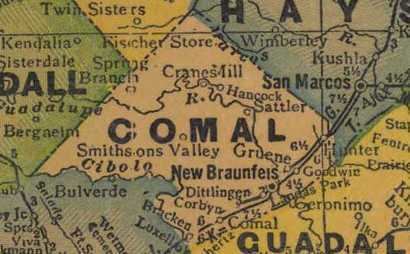Area 1,489 km² Population 118,480 (2013) | Website www.co.comal.tx.us Founded 1846 University Seguin Beauty School | |
 | ||
Rivers Guadalupe River, West Fork Cibolo Creek, Cypress Creek | ||
Texas bounty hunters comal county texas top ten most wanted capture
Comal County (/ˈkoʊmæl/ KOH-mal) is a county located on the Edwards Plateau in the U.S. state of Texas. As of the 2010 census, its population was 108,472. Its county seat is New Braunfels.
Contents
- Texas bounty hunters comal county texas top ten most wanted capture
- Map of Comal County TX USA
- Canyon lake texas comal county
- History
- Darmstadt Society of Forty
- Geography
- Major highways
- Adjacent counties
- Demographics
- Politics
- Cities multiple counties
- Cities
- Towns
- Census designated place
- Unincorporated Community
- Ghost Towns
- In popular culture
- References
Map of Comal County, TX, USA
Comal County is part of the San Antonio-New Braunfels, TX Metropolitan Statistical Area.
Canyon lake texas comal county
History
Darmstadt Society of Forty
Count Castell of the Adelsverein negotiated with the separate Darmstadt Society of Forty to colonize two hundred families on the Fisher-Miller Land Grant territory in Texas. In return, they were to receive $12,000 in money, livestock, equipment and provisions for a year. After the first year, the colonies were expected to support themselves. The colonies attempted were Castell, Leiningen, Bettina, Schoenburg and Meerholz in Llano County; Darmstädler Farm in Comal County; and Tusculum in Kendall County. Of these, only Castell survives. The colonies failed after the Adelsverein funding expired, and also due to conflict of structure and authorities. Some members moved to other Adelsverein settlements in Texas. Others moved elsewhere, or returned to Germany.
Geography
According to the U.S. Census Bureau, the county has a total area of 575 square miles (1,490 km2), of which 559 square miles (1,450 km2) is land and 15 square miles (39 km2) (2.7%) is water.
The Balcones Escarpment runs northeastward through the county, generally just west of Interstate 35. West of the escarpment are the rocky hills and canyons of the Texas Hill Country; to the east are the rolling grasslands of the coastal plains.
The Guadalupe River flows generally southeastward through the county, and is impounded by Canyon Lake. The Comal River rises from the Comal Springs in New Braunfels, and quickly joins the Guadalupe River.
Major highways
Adjacent counties
Demographics
As of the census of 2010, there were 108,472 people, 29,066 households, and 21,886 families residing in the county. The population density was 139 people per square mile (54/km²). There were 32,718 housing units at an average density of 58 per square mile (22/km²). The racial makeup of the county was 89.08% White, 0.95% Black or African American, 0.53% Native American, 0.46% Asian, 0.03% Pacific Islander, 6.98% from other races, and 1.96% from two or more races. 22.57% of the population were Hispanic or Latino of any race.
There were 29,066 households out of which 33.30% had children under the age of 18 living with them, 62.80% were married couples living together, 9.00% had a female householder with no husband present, and 24.70% were non-families. 20.60% of all households were made up of individuals and 9.00% had someone living alone who was 65 years of age or older. The average household size was 2.64 and the average family size was 3.05.
A Williams Institute analysis of 2010 census data found there were about 4.4 same-sex couples per 1,000 households in the county.
In the county, the population was spread out with 25.50% under the age of 18, 7.00% from 18 to 24, 27.50% from 25 to 44, 25.20% from 45 to 64, and 14.80% who were 65 years of age or older. The median age was 39 years. For every 100 females there were 96.00 males. For every 100 females age 18 and over, there were 93.20 males.
The median income for a household in the county was $46,147, and the median income for a family was $52,455. Males had a median income of $36,048 versus $25,940 for females. The per capita income for the county was $21,914. About 6.40% of families and 8.60% of the population were below the poverty line, including 11.50% of those under age 18 and 7.30% of those age 65 or over.
Politics
The county is part of the 21st District in the United States House of Representatives, represented by Republican Lamar S. Smith, the 25th district of the Texas State Senate, represented by Republican Donna Campbell, and the 73rd District of the Texas House of Representatives and is represented by Republican Kyle Biedermann. Biedermann's predecessors in the House seat are Republicans. They include Nathan Macias, a businessman from Bulverde, Carter Casteel, a former Comal County county judge and a lawyer in New Braunfels, and Doug Miller, a former mayor of New Braunfels.
